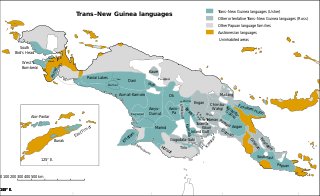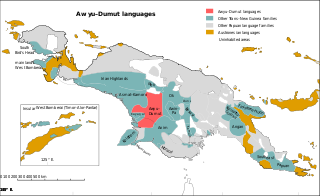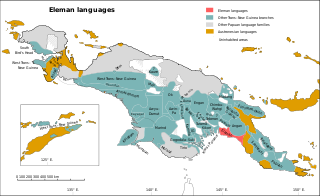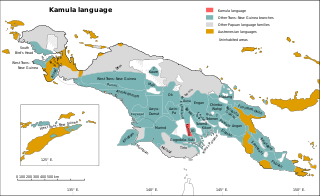Related Research Articles

Trans–New Guinea (TNG) is an extensive family of Papuan languages spoken in New Guinea and neighboring islands, perhaps the third-largest language family in the world by number of languages. The core of the family is considered to be established, but its boundaries and overall membership are uncertain. The languages are spoken by around 3 million people. There have been three main proposals as to its internal classification.

The East Geelvink Bay or East Cenderawasih languages are a language family of a dozen Papuan languages along the eastern coast of Geelvink Bay in Indonesian Papua, which is also known as Sarera Bay or Cenderawasih.
The Brahman languages, Biyom and Tauya, form a subbranch of the Rai Coast branch of the Madang languages of Papua New Guinea. The family is named after the cattle station and town of Brahman, which lies between the territories of the two languages.
Tauya is a Rai Coast language spoken in the Ramu River valley, Madang Province, Papua New Guinea by approximately 350 people. The Linguistics Department at the University of Manitoba in Winnipeg, Canada, has Tauya language resources.
The Nimboran languages are a small family of Papuan languages, spoken in the Grime River watershed, that had been part of Stephen Wurm's Trans–New Guinea proposal. However, when proto-Nimboran pronouns are reconstructed (*genam "I" and kom or komot "thou"), they have little resemblance to the proto-TNG pronouns *na and *ga. Usher places them in a North Papuan stock that resembles Cowan's proposal.
The Piawi languages are a small family of Papuan languages spoken in the Schraeder Range of the Madang Highlands of Papua New Guinea that had been part of Stephen Wurm's Trans–New Guinea proposal. They are now connected to the Arafundi and Madang languages.

The Eastern Trans-Fly languages are a small independent family of Papuan languages spoken in the Oriomo Plateau to the west of the Fly River in New Guinea.

The Greater Awyu or Digul River languages, known in earlier classifications with more limited scope as Awyu–Dumut (Awyu–Ndumut), are a family of perhaps a dozen Trans–New Guinea languages spoken in eastern West Papua in the region of the Digul River. Six of the languages are sufficiently attested for a basic description; it is not clear how many of the additional names may be separate languages.
The Pauwasi languages are a likely family of Papuan languages, mostly in Indonesia. The subfamilies are at best only distantly related. The best described Pauwasi language is Karkar, across the border in Papua New Guinea. They are spoken around the headwaters of the Pauwasi River in the Indonesian-PNG border region.

The Eleman languages are a family spoken around Kerema Bay, Papua New Guinea.
The Mabuso languages are a small family of closely related languages in New Guinea. They were linked with the Rai Coast languages in 1951 by Arthur Capell in his Madang family, which Wurm (1975) included in his Trans–New Guinea (TNG) phylum. Malcolm Ross reconstructed the pronouns of proto-Mabuso and noted that "the integrity of the Mabuso group is fairly obvious".

The Madang or Madang–Adelbert Range languages are a language family of Papua New Guinea. They were classified as a branch of Trans–New Guinea by Stephen Wurm, followed by Malcolm Ross. William A. Foley concurs that it is "highly likely" that the Madang languages are part of TNG, although the pronouns, the usual basis for classification in TNG, have been "replaced" in Madang. Timothy Usher finds that Madang is closest to the Upper Yuat River languages and other families to its west, but does not for now address whether this larger group forms part of the TNG family.

The Kainantu–Goroka language are a family of Papuan languages established by Arthur Capell in 1948 under the name East Highlands. They formed the core of Stephen Wurm's 1960 East New Guinea Highlands family, and are one of the larger branches of Trans–New Guinea in the 2005 classification of Malcolm Ross.

The Chimbu–Wahgi languages are a language family sometimes included in the Trans–New Guinea proposal.
The Ramu languages are a family of some thirty languages of Northern Papua New Guinea. They were identified as a family by John Z'graggen in 1971 and linked with the Sepik languages by Donald Laycock two years later. Malcolm Ross (2005) classifies them as one branch of a Ramu – Lower Sepik language family. Z'graggen had included the Yuat languages, but that now seems doubtful.
The Ottilien or Watam-Awar-Gamay languages languages are a small family of clearly related languages,

The Ram languages are a small group of 3 languages spoken in Sandaun Province, Papua New Guinea. They are spoken directly to the northeast of the Yellow River languages and directly to the south of the Wapei languages, both of which are also Sepik groups. Ram is the word for 'man' in the languages that make up this group.

Kamula is a Trans–New Guinea language that is unclassified within that family in the classification of Malcolm Ross (2005). Noting insufficient evidence, Pawley and Hammarström (2018) leave it as unclassified.
The Sogeram languages are a family of languages in the Madang stock of New Guinea. They are named after the Sogeram River.
Proto-Trans–New Guinea is the reconstructed proto-language ancestral to the Trans–New Guinea languages. Reconstructions have been proposed by Malcolm Ross and Andrew Pawley.
References
- ↑ "South Madang - newguineaworld". sites.google.com. Archived from the original on 2014-09-06.